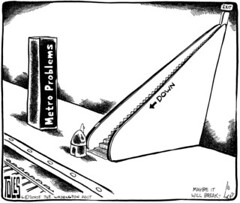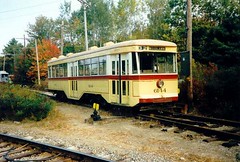Regional Transportation Roundup

1. From today's paper, in response to the Washington Post series and the articles that have followed including "1 Billion Metro Plan Adds Jobs, Rail Cars: No Fare Increase in Budget Proposal That Wins Tentative Approval From Directors" and "GAO Asked To Investigate Metro Costs: Many Seek to Expand Oversight of Spending."
Clearly there needs to be an increase in responsiveness, transparency, and expectations for excellence, although given that Congress was the entity that forced the destruction of the remaining Washington streetcar system that managed to survive the onslaught of the personal automobile, the Federal Government is hardly blameless...
 Car 6144 from Baltimore, Maryland. Fred Maloney photo Car circa 1930 J. G. Brill Manufacturing, Peter Witt - Modern Lightweight Trolley Car. From the Seashore Trolley Museum, Kennebunkport, Maine.
Car 6144 from Baltimore, Maryland. Fred Maloney photo Car circa 1930 J. G. Brill Manufacturing, Peter Witt - Modern Lightweight Trolley Car. From the Seashore Trolley Museum, Kennebunkport, Maine.2. Interesting developments in Maryland
a. In "Trolley travel could be in city's future: Group hoping trolley can put downtown tourism on right path" the Sun reports:
"If there's a streetcar named desire, Baltimore boosters are hoping to catch a ride on a trolley named development.An organization charged with revitalizing the Charles Street corridor is studying whether a trolley system, extinct in the city since the 1960s, could be the answer.
The Charles Street Development Corp. is studying the feasibility of installing a 7.5-mile trolley line that would link the Inner Harbor with the Johns Hopkins University. It would drop riders at the door of city attractions such as the Walters Art Museum, the Lyric Opera House and the Baltimore Museum of Art - sights that most tourists spend days in the city not seeing.
And, the thinking goes, it might even cause developers to take another look at vacant lots in Mount Vernon, closed-down restaurants in the arts district and struggling neighborhoods that surround Penn Station."All up and down Charles Street, business would benefit," said Rebecca Gagalis, Charles Street Development Corp.'s executive director. "It would really, really be a huge benefit to small business."
* If this is coordinated with DC's own streetcar studies, and if the two systems used the same cars, perhaps this could reduce overall cost of production.
It could also help push some ideas Dr. Transit has floated about streetcar service in Prince Georges County (1) extending the proposed DC crosstown line from Brookland up Michigan Avenue-Queens Chapel Road-Adephi Road into the Northward part of the UMD campus, to the College Park station and back south through the campus back to Adelphi Road for the return, and (2) creating a Rhode Island-Rte. 1 service that could start at the Rhode Island Metro station and goes as far as Laurel. (One of these days I'll draw this out and post an entry on it.)
 Proposed Trolley Route.
Proposed Trolley Route.b. In the "are the military base closures proposed for the region designed to enable sprawl department?" today's Baltimore Sun reports that "Md. quietly plans for a rail link to [Fort] Meade: Discussions described as conceptual; new line would be at least 20 years away". As reported in the Washington Post a couple weeks ago, Fairfax County and Dept. of Defense officials are thinking about WMATA expansion to Ft. Belvoir--see this report from NewsChannel 8.
Relatedly, transit doesn't always have to promote compact development and density, it can be used to enable greenfield development, which imo was always the problem with the "Outer" vs. the "Inner" "Purple Line" which alas is on life support at the moment as the Inner County Connector highway is the number one transportation priority of the State of Maryland at this time. (See "Council Leaves Connector Out of Plan")
c. In the public transit breeds crime and trash department the Sun also reports in "Community groups leery of proposed MTA commuter line: Neighborhood leaders fear it could bring crime, trash; agency seeks public input" that not everybody thinks expanding transit is a good thing.



0 Comments:
Post a Comment
<< Home